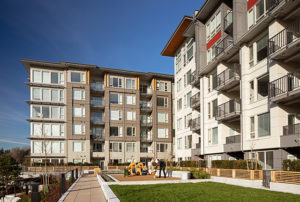 Statistics Canada conducted the first Canadian Housing Survey in 2018, and intends to run it biennially until 2028. The data are being released in stages. In November, the main trends reported were:
Statistics Canada conducted the first Canadian Housing Survey in 2018, and intends to run it biennially until 2028. The data are being released in stages. In November, the main trends reported were:
- Mobility (35% of Canadians moved in the past year, most within the same city)
- Affordability (Toronto and Vancouver continue to face problems while Calgary and Edmonton saw falling housing prices after the drop in oil prices in 2014)
- Satisfaction (4 out of 5 Canadians reported that they were satisfied with their home and neighbourhood, ranging from 77.0% in Toronto and Vancouver to 92.5% in Québec)
- Social housing (1 of 10 renters across the country lives in social housing, about 13.5% of all households, with the highest rates in Nunavut (75.0%), Northwest Territories (38%) and Québec (10.2%). An estimated 283,000 households (1.2%) are on the waiting list for social housing (24% of households in Nunavut were on a waitlist, compared to just 1.3% in British Columbia and 1.4% in Nova Scotia)
- Suitability (about 5.1% or 741,000 households) lived in housing that did not have enough bedrooms for the occupants. Renter households were three times as likely to live in unsuitable dwellings
- Adequacy (7.1% o or 1,052,900 households lived in housing in need of major repairs, with the highest percentage in Montréal). Slightly more renters than owners (8.5% versus 6.5%) reported the need for major repairs
In January, we learned that just 9% of households in Canada bought their first home in the past five years, with the highest rates in Alberta, Saskatchewan, and the Yukon.
- Household type: the vast majority of first-time homebuyers are what Statistics Canada terms “families” (couples with children, couples without children, lone parents, and multi-family households). Of these, the most significant groups were couples with children (33% of first-time homebuyers) and couples without children (26% of first-time homebuyers), though surprisingly, single-person households weren’t that far behind (21%). Just 29% of first-time homebuyers had visible minority status
- Housing type: 47% of first-time homebuyers chose a dwelling that was not single-family detached (e.g. townhouse, apartment or flat, or movable dwelling)
- Motivation: the most common reasons for buying a home were to become a homeowner (66%), to form their own household (26%), or to upgrade to a larger or better quality dwelling (26%). Other common reasons were to move to a more desirable neighbourhood (16.3%) and changes in household/family size (13.6%)
- Affordability: 23.7% of first-time homebuyers said that it was very difficult or difficult to meet their financial needs, while 44.0% said it was neither difficult nor easy. 33.1% reported that it was either easy or very easy to meet their financial needs
So far, these results are not surprising to those of us in housing research. However, municipal planners and policy makers should note that the majority of households who are buying are not couples with children, and that almost half of first-time homebuyers are buying apartments/flats or townhouses. This represents a major shift in thinking for most developers, who are still producing way too many large suburban homes. The shift to mid-rise and high-rise living seems to be trending across the country, but regional differences persist: the much higher levels of living in social housing, and waiting for social housing, in Nunavut and Northwest Territories is cause for concern. It’s not surprising that households report the highest levels of satisfaction in Québec, which has historically invested much more in affordable housing than other cities due to the strong support of the province.
